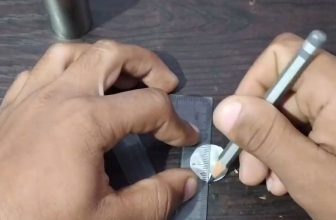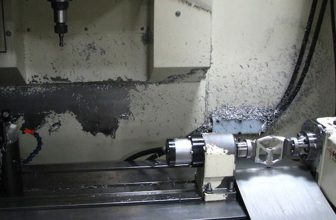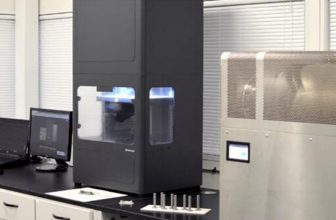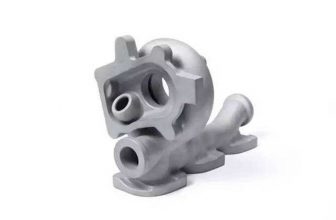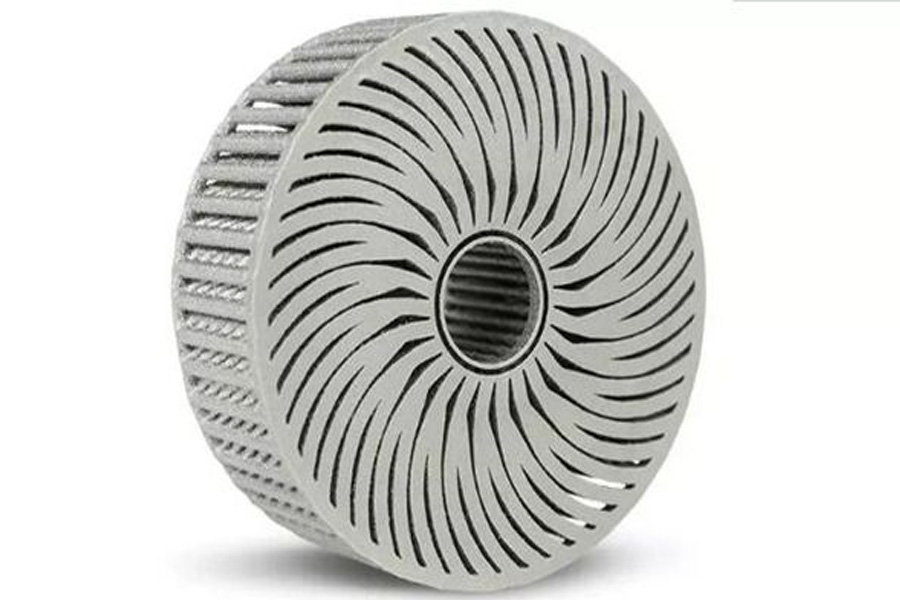
There is no doubt that 3D printing (also known as additive manufacturing in industry; AM) is already triggering a transformation in manufacturing. From rapid delivery of spare parts to customized production, additive manufacturing technology can help simplify equipment maintenance, speed up the development process, and pass functions. Oriented design to improve product performance.
At the same time, materials engineers are actively expanding the boundaries of 3D printing materials, including not only plastics and metals, but also nanomaterials, bio-based materials, etc. 3D printing is gradually becoming the mainstream manufacturing technology. In this issue, 3D Science Valley and Gu Youlai jointly appreciate the challenges and status quo of incorporating 3D printing into mainstream manufacturing technology. “3D printing has become the latest state of mainstream manufacturing technology” will be divided into two parts for industry development perspective, the first part will focus on the basic construction of 3D printing into mainstream manufacturing technology.
Cooperation is more important than competition, sharing is the best policy
Security Supervision and Intellectual Property
3D printing/AM additive manufacturing technology provides manufacturers with unprecedented flexibility, and also introduces some sensitive issues that the industry is just beginning to understand in terms of security, regulation, and intellectual property (IP). According to market observations from 3D Science Valley, in order to solve these problems, Pennsylvania State University is offering the first postgraduate course on the legal issues of additive manufacturing.
According to Pennsylvania State University, with additive manufacturing technology, one of the challenges is how to protect the design of parts. Sometimes people may not realize that they may violate other people’s intellectual property rights. In some cases, copying parts can be as simple as scanning parts, thereby generating a 3D solid model of the part that can be 3D printed. Pennsylvania State University has developed a method for authenticating 3D printed parts, including embedded chemical tags-basically a “fingerprint” that can be detected by spectroscopy to provide verification of the source of the part. For example, if you want to print titanium alloy parts, users can print auxiliary materials that do not affect the properties of the parts, but can be used to verify whether the parts are authentic.
Verification and standardization
When considering the safety aspects of using 3D printed parts in critical industrial applications, verification and standardization are also essential, but relevant standards for regulated industries have not yet been fully realized. For example, there is currently no ASME pressure for AM additive manufacturing components. Container standards, however, the rapid development of AM technology requires the rapid development of new standards for new additive manufacturing parts.
A key to standardization is cross-industry collaboration and data sharing, which is especially suitable for demanding applications with high fatigue resistance requirements or particularly high temperatures or pressures. The American National Standards Institute (ANSI) and America Makes have launched standards coordination work to bring together relevant data on AM additive manufacturing technology and part standardization. ASTM has also done a lot of work in this area. But there is still a lot of work to be done, because many companies are reluctant to share proprietary research or operational data, especially for those data generated at millions of dollars. Oerlikon has also done a lot of work in sharing data. Through cooperative development with industrial manufacturers, data is shared with FAA and other organizations to pave the way for 3D printing to enter mainstream manufacturing technology. In most cases, cooperation is more important than competition, and sharing is more conducive to development than confidentiality. For powder bed selective metal melting 3D printing technology, 3D printing pressure vessels is still an area of special concern, as are heat exchangers and radiators, and lightweight parts with lattice structure-less materials can be used , And still meet the performance requirements, these are completely changing the economics of components.
Commercial verification
Even with the potential for customization and process optimization, users must continue to ensure that all processes of their facilities meet inspection requirements. Independent verification and identification is a way to reduce risks and unknown factors. In this regard, Lloyd’s Register (LR London) has cooperated with TWI Ltd. (Cambridge, UK) to develop a set of special guidelines aimed at Metal parts are certified, and 3D printing facilities have been certified since 2016. These guidelines examine many factors, including: raw material receipt, storage and handling; equipment qualification; process control; personnel training; health, safety and environmental considerations, etc. Recently, LR applied its guidelines to inspect and appraise the powder bed melting 3D printing facility operated at the Shell Technology Center in Amsterdam. In 3D printing, many variables will affect the mechanical properties of parts, which may bring various risks to the consistency of the produced parts. LR’s qualifications prove that the process and quality control reduces operational risks.
Shell is developing an AM additive manufacturing project. Currently, Shell is developing what is said to be the world’s first 3D printed pressure vessel. In this pioneering effort, it is important to pass product qualification certification, not only to meet legal and safety requirements, but also to contribute to collaboration in the supply chain, which will benefit the entire industry. With the development of new technologies, standards and regulations also need to be developed to facilitate the incorporation of these new ways of working, and to ensure that they are safe and meet legal requirements, thereby providing end users with guarantees of quality and manufacturing capabilities.
There is no doubt that 3D printing (also known as additive manufacturing in industry; AM) is already triggering a transformation in manufacturing. From rapid delivery of spare parts to customized production, additive manufacturing technology can help simplify equipment maintenance, speed up the development process, and pass functions. Oriented design to improve product performance.
At the same time, materials engineers are actively expanding the boundaries of 3D printing materials, including not only plastics and metals, but also nanomaterials, bio-based materials, etc. 3D printing is gradually becoming the mainstream manufacturing technology. In this issue, 3D Science Valley and Gu Youlai jointly appreciate the challenges and status quo of incorporating 3D printing into mainstream manufacturing technology. “3D printing has become the latest state of mainstream manufacturing technology” is divided into two parts for the perspective of industry development. The next part will focus on the progress of 3D printing materials and processes.
More choices, better performance
One of the most exciting areas is the development of new materials in the metal field. Metal 3D printing is being applied more and more widely from the 3D printing applications of high-end titanium alloys, nickel-based superalloys and other materials to stainless steel, copper alloys, and aluminum alloys. The 3D printing field of other materials, thereby expanding the application prospects of 3D printing parts.
1.Titanium alloy
The process cost from US$70 per kilogram to US$2.5 per kilogram?
In 2018, the Fast Forge (FAST-forge) project funded by Innovate UK aims to develop a cheaper and more abundant titanium powder manufacturing process. This lower-cost titanium powder 3D printing material will further open up the market space of titanium in the field of additive manufacturing. Not only is the production of titanium metal powder faster, but also cheaper, the metal 3D printing process of titanium will also be improved. Britain seems to be brewing a disruptive titanium metal powder production and titanium metal parts manufacturing technology.
DSTL National Defense Science and Technology Laboratory simplified the 40-stage process of titanium powder production into two steps, which may cut the production cost of titanium parts by half and completely changed the production of titanium. Metalysis, headquartered in Rotherham, South Yorkshire, also participated in the FAST-forge project. According to market observations from 3D Science Valley, Metalysis also received US$17 million in funding to advance the R&D and manufacturing capabilities of 3D printable metal alloy powders. Metalysis is developing a powder production process that can produce alloys at a lower cost. powder.
Metalysis’s proprietary technology can directly electrolyze titanium metal into powder form using rutile. It claims that its proprietary technology uses less energy than conventional titanium powder manufacturing companies and can save at least 50% of energy. It is said that the FFC method will reduce the manufacturing process cost of spherical metal powder for metal 3D printing from the current US$70/kg to US$2.50/kg.
2.Stainless steel
Modified steel
In the laser metal melting process of the SLM selective area, the fast-moving laser melts the metal particles to form a “track” of the molten metal. This kind of melting rail is very fragile and easily collapses, especially at low inclination angles. The Graz University of Technology in Australia has developed a method to improve the surface of stainless steel particles so that the inclined surface of the part will not be deformed during the 3D printing process, thereby reducing the cost associated with the support structure.
The surface of the particles has been modified so they can interact with molten metal more intelligently. In addition, by making steel powder easier to 3D print, material waste can be reduced, and more excess steel powder can be recovered at the end of the process. At present, it is mainly concentrated on 316L stainless steel, but the Graz University of Technology also has plans to expand to other steel grades.
It is expected that this material will be demonstrated for industrialization in 2020, and commercial products will enter the market. This modified steel powder material is particularly suitable for topology optimization components, lattice structures and advanced pipeline and valve systems. Velo 3D, a startup company located on the west coast of the United States, has developed a smart molten metal 3D printing system that can handle angles as low as 10 degrees, thereby reducing the need for supporting structures.
Low-alloy steel
GKN’s low-alloy steel expands the range of materials for the laser powder bed molten metal 3D printing process (LPBF) and the binder jetting metal 3D printing process (Binder Jetting). ANCORAM 4605 of GKN additive manufacturing material is a gas or water atomized low-alloy steel powder containing nickel, molybdenum and manganese. It has been on the market and is considered to be an ideal choice for manufacturing special thick section parts. The grain size of all low-alloy steels are suitable for LPBF and binder jetting processes.
GKN has also successfully developed 20MnCr5, another low-alloy steel powder material, suitable for automotive prototype manufacturing applications, and provides the mechanical properties required for automotive parts. According to market observations from 3D Science Valley, Porsche Engineering has developed a new electric power system after determining the application feasibility of this material. 20MnCr5 steel powder has high strength, high ductility, high fatigue strength, and has excellent wear resistance through surface hardening. The 20MnCr5 material has opened up a new space for additive manufacturing for the automotive industry. The automotive industry will first use this low-alloy steel material for prototype manufacturing, and then confirm whether it can be extended to mass production applications. Parts manufactured by 3D printing allow engineers to complete design verification within a few weeks (if not a few days) and enter the next design iteration cycle.
In addition to 20MnCr5 powder, GKN additive manufacturing materials has also developed a series of low-alloy steel powders for additive manufacturing. These powders are different in hardenability, heat treatment and mechanical properties. The difference between each powder is the different metal composition, which contains different levels of carbon (C), silicon (Si), manganese (Mn), molybdenum (Mo), nickel (Ni) and chromium (Cr).
Wear-resistant steel
VBN Components, a Swedish metal powder material company, has developed a new generation of high-strength, carbide-containing high-speed steel materials in combination with specific industrial application requirements and additive manufacturing-3D printing processes. This type of material is suitable for the manufacture of wear-resistant parts, such as gear processing tools, food processing equipment parts, and mining equipment parts. Wear-resistant steel materials have a wide range of industrial uses. They are materials that are difficult to process with traditional manufacturing techniques. VBN realizes the manufacture of such materials through electron beam melting (EBM) 3D printing technology.
The EBM metal 3D printing high-alloy high-speed steel powder material developed by VBN is named the Vibenite series. At present, 5 different types of materials have been developed: corrosion-resistant, wear-resistant Vibenite 350 high-alloy steel; high wear-resistant, high-toughness high-alloy steel Vibenite 150; wear-resistant and heat-resistant material Vibenite 280; hard material Vibenite 290; new hybrid cemented carbide Vibenite 480.
Among them, Volvo Construction Equipment is using gear hobbing cutters made of Vibenite 280 material and compared with standard gear hobbing cutters made of traditional high-alloy steel. The conclusion is that when a tool made of Vibenite 280 material runs at a normal feed (the cutting depth is the same), the tool life is extended to 2.2 times.
At the end of 2018, VBN signed a multi-million-euro license agreement with a global engineering group that included the use of VBN materials and additive manufacturing processes to produce high-strength components for a specific segment. VBN is currently also testing the application of Vibenite 480 3D printed parts in rock drilling with Epiroc, a rock drilling company.
3.Copper alloy
The development of materials and lasers promotes 3D printing of copper alloys
Copper does not seem to be suitable for processing in 3D printing, because this metal easily directly reflects the laser beam of a 3D printer. The absorption rate of copper metal in the laser melting process is low, and it is difficult for the laser to continuously melt the copper metal powder, resulting in low forming efficiency and difficult control of metallurgical quality.
Following the heat test of 3D printed GRCop-84 components at the Marshall Space Flight Center in 2016 and 2017, NASA’s copper-based and nickel-based alloy 3D printing technology has been developed to the extent that the parts manufactured by these technologies pass the heat test. According to market observations from 3D Science Valley, many manufacturing companies are developing copper alloy 3D printing processes. Blite, a domestic metal 3D printing company, has made progress in the field of copper metal laser forming. It has developed a 3D printing process for refractory metals and high thermal conductivity and high reflective metals, and realized the copper material manufacturing process with complex runners, and successfully prepared 3D printed copper alloy tail nozzle.
Internationally, Aerojet Rocketdyne’s breakthrough in the field of 3D printing of rocket copper alloy thrust chambers has brought the possibility of manufacturing a new generation of RL10 engines. The 3D printed copper alloy thrust chamber parts will replace the previous RL10C-1 thrust chamber parts. The thrust chamber component to be replaced is manufactured by a traditional process and is welded by multiple stainless steel parts, while the 3D printed copper alloy thrust chamber component is composed of two copper alloy parts.
Launcher, a start-up aerospace company, and its partners 3T and EOS have also developed 3D printed copper alloy rocket engine components. The application of 3D printing technology can reduce the number of engine parts, shorten development time, and make it easier to manufacture complex functional integrated components. Launcher developed 3D printed copper alloy (Cucrzr) engine parts integrate complex cooling channels. This design will improve engine cooling efficiency.
Regarding copper lasers for 3D printing, according to IDTechEx Research’s “Laser Diodes and Direct Diode Lasers, 2019-2029: Technology, Market and Forecasts” report, the average power of laser diodes has increased significantly over the past 30 years, while the average price per watt But it declined exponentially. Therefore, laser diodes are replacing some of the existing laser and non-laser technologies, while also making new optical technologies possible.
In 2018, Shimadzu Corporation intends (Japan) to commercialize its BLUE IMPACT blue impact diode laser. A key application of Shimadzu’s 450nm blue diode laser is the 3D printing of copper materials. Copper has a high absorption rate for blue lasers, and the reduction of back reflection can make the processing process faster, which is a severe challenge to traditional infrared lasers. The newly developed 3D printer can print objects efficiently with pure copper powder. Existing 3D printer technology generally uses copper alloys such as CuCr1Zr to replace pure copper.
4.Aluminum alloy
The aluminum alloy that began to cross the development threshold
SLM selective area metal melting technology
Aluminum alloy, due to its natural lightweight characteristics, occupies an important place in the field of industrial manufacturing. According to SmarTech’s forecast, aluminum alloys account for all metal powder consumption in metal 3D printing (calculated by volume) and gradually increase from 5.1% in 2014 to 11.7% in 2026. Aluminum alloys have a 10-year compound growth rate in the automotive industry. At 51.2%. The global supply chain of aluminum alloy materials seems to have “crossed the threshold” and become the next generation opportunity to support additive manufacturing technology. 3D printing of aluminum alloys is now beginning to catch up with nickel, steel and titanium.
AlSi12-AlSi12 is a lightweight additive manufacturing metal powder with good thermal properties. The AlSi10Mg-silicon/magnesium combination brings a significant increase in strength and hardness. This aluminum alloy is suitable for thin-walled, complex geometrical parts, and is an ideal material for applications where good thermal performance and low weight are required. The parts are densely organized and have similarities to cast or forged parts. Typical applications include automotive, aerospace, and aerospace industrial grade prototypes and production parts, such as thin-walled parts such as heat exchangers.
The die-casting alloy AlSi10Mg is similar to the American alloy 360. Although this is not a widely recognized high-strength casting alloy, it has been proven to produce quite high strength through appropriate heat treatment. 3D Science Valley understands that although this fact is also available Controversial. But broadly speaking, this alloy can be artificially aged through standard heat treatment processes after solution treatment, which is called the T6 cycle. Solution treatment is above 500°C, 4-12h, the temperature should not exceed 550°C, followed by water or polymer melt quenching. The artificial aging temperature is between 155°C-165°C, the time is 6-24h, and the final performance is controlled by precise time and temperature. The tensile strength can be between 220MPa and 340MPa, and the tensile yield strength is between 180MPa and 280MPa. Other alloys include 169 (A357) and AlSi7Mg.
In addition, market research and other proprietary alloys such as Scalmalloy have been used in Airbus’s additive manufacturing applications, which are some exciting developments. Researchers in the HRL laboratory selected zirconium-based nanoparticle nucleating agents based on crystallographic information and assembled them into 7075 and 6061 series aluminum alloy powders. After functionalization with nucleating agents, these high-strength aluminum alloys that were previously incompatible with additive manufacturing can be successfully processed using powder bed selective laser melting equipment. The formed material has no cracks and is equiaxed (that is, the grains in its length, width and height are approximately equal), achieving a fine-grained microstructure and having comparable material strength to the forged material.
According to China Daily, the research team of Monash University led by the founder of Suzhou Beifeng and Academician Wu Xinhua of the Australian Academy of Engineering has successfully developed a high-strength and high-toughness aluminum alloy material for additive manufacturing with the brand name Al250C, adding another star to 3D printing aluminum alloy materials. member. Al250C is a material specially designed by the research team for 3D printing, and it has reached the stage of mass production and commercial use. The strength of Al250C material reaches the highest level among aluminum alloy materials currently available for 3D printing. The yield strength can reach 580MPa, the tensile strength is more than 590MPa, and the elongation rate can reach 11%. The prepared components have passed the stability test for 5000 hours at a high temperature of 250℃. , Which is equivalent to the requirement of 25 years of regular service of the engine.
The parts made of the aluminum alloy powder A20X patented by the British-based foundry expert Aeromet International for additive manufacturing have exceeded the ultimate tensile strength (UTS) of 500MPa. Aeromet claims that this achievement makes the aluminum alloy material “one of the strongest aluminum alloy powders commercially available for additive manufacturing.” A20X is an aluminum-copper alloy material with a fine microstructure. Compared with other alloys, it has “high strength, fatigue resistance and optimized thermal performance.” At present, it has obtained the development and standardization of metal material characteristics (MMPDS) and Approval of the Aerospace Material Standard (AMS), the material has been adopted by the world’s leading aerospace casting suppliers.
A few years ago, Nanjing University of Aeronautics and Astronautics developed aluminum-based nanocomposites based on SLM forming for use in the field of laser additive technology, effectively solving the mismatch and enhancement of aluminum-based nanocomposites in the process and mechanical properties of the laser additive process. The uneven particle distribution and poor wettability between the ceramic phase and the substrate phase make the obtained product have good interface bonding and excellent mechanical properties.
Binder jet indirect metal 3D printing technology
The above is the development of aluminum alloy processed by SLM selective laser metal melting 3D printing technology. With the development of aluminum alloy materials and binder technology, it is more feasible to realize the additive manufacturing of aluminum alloy parts through the indirect metal 3D printing process of binder injection. According to 3D Science Valley market observations, materials science company Equispheres has developed a new type of aluminum alloy powder suitable for binder jet 3D printing. Equispheres cooperated with McGill University in Canada to test AlSi10Mg aluminum alloy powder. It was observed that Equispheres standard AlSi10Mg aluminum alloy powder has no compression, sub-solid phase sintering, and has good densification (better than 95%) and excellent microstructure And other characteristics, the material can be applied to the sintering process in binder jet 3D printing and its post-processing.
As an aluminum alloy material that is used extensively in automobile manufacturing, it has always been difficult to catch up with the downwind of the binder injection technology to realize the additive manufacturing of auto parts at a lower cost and higher efficiency. The main reason is that the binder jet 3D printing process requires post-sintering treatment after the printing is completed, which easily causes the aluminum alloy to burn, which is a major challenge for the binder jet 3D printing to process aluminum alloys. From this point of view, the aluminum alloy powder that Equispheres has introduced that can be used for binder injection technology opens up a new space for the application of this technology. However, whether the mechanical properties and hardness of the binder jet 3D printed aluminum alloy can meet the requirements of the automotive parts manufacturing field, 3D Science Valley will remain concerned.
3D printing sand mold + casting
In addition, 3D printing sand molds and casting methods are a practical and feasible method for producing magnesium-aluminum alloys. According to the market observation of 3D Science Valley, internationally, regarding the lightweight application of casting in the field of transportation, a realistic example is Autodesk’s voxeljet-Voxel 3D printing equipment to make investment molds and cast magnesium and aluminum alloys. Realize the lightweight of aircraft seats. This seat structure is suitable for any standard commercial jet aircraft and is expected to save airlines millions of dollars in cost through weight reduction.
Diamond and cemented carbide
1.Diamond
Researchers in Sandvik’s Additive Manufacturing Division have developed a slurry composed of diamond powder and polymer through stereolithography (SLA) for 3D printing of diamond composite materials. The material has been tested and maintains the physical properties of pure diamond.
Sandvik has developed a proprietary post-processing step. The composite material is three times harder than steel, has a higher thermal conductivity than copper, and a density close to aluminum. From power generation to mining to medical implants, a variety of industries are Can benefit from 3D printing diamonds.
2.Cemented carbide
Hunan Yishu Intelligent Manufacturing Co., Ltd. has developed a cemented carbide material additive manufacturing-3D printing process. In this process, the WC-Co cemented carbide layer and the diamond layer in the cemented carbide-diamond composite material pass through 3D The way of printing realizes the combination between layers. This kind of bonding is done through chemical bonding. Compared with traditional physical bonding, this kind of bonding is stronger. It can avoid the peeling of the coating during use and has better hardness at the same time.
The additive manufacturing process adopted by Hunan Yishu Intelligent Manufacturing is Electron Beam Melting (EBM) 3D printing technology based on powder bed melting. Based on this process, the WC-Co cemented carbide layer-diamond composite material Research on additive manufacturing process parameters.
Material research includes the mass content and particle size of Co in WC-Co cemented carbide, the particle size and purity of diamond material, and the mass ratio of the two materials. In terms of process parameters, Hunan Yishu Intelligent Manufacturing has explored the 3D printing parameters of this composite material, such as the scanning rate, current, and melting temperature of the electron beam melting scan.
Through the samples manufactured by the above process, a cemented carbide with a thermal conductivity of 500-550W/mK, a friction coefficient of 0.3-0.5, a thermal expansion coefficient of 0.9-1.18×10-6, and a hardness value of 4800-5000HV can be obtained- Diamond composite material, the material has good hardness, impact toughness is 300 ~ 320J, can well avoid the peeling of the coating.


